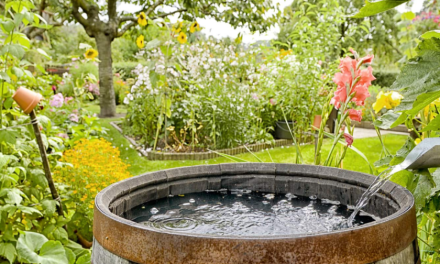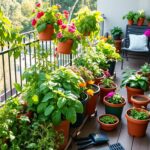Did you know balcony gardens can grow up to 240 plants from one seed tray? This shows you don’t need much space to grow your food. You can turn your balcony into a lush garden, no matter where you live.
This guide will show you how to start a balcony garden. You’ll learn about choosing plants and harvesting your food. With a few simple steps, you can grow your own food right on your balcony!
Understanding the Benefits of a Balcony Garden
Turning your balcony into a garden is a great way to use small outdoor spaces. It lets you grow herbs and veggies even in tiny areas. Many city folks want to garden on their balconies, showing the appeal of balcony gardens.
Maximize Limited Outdoor Space
Using a balcony for gardening can be tough, but it’s doable. Balconies are small, but you can fit a lot of plants there. By using walls and railings, you can grow more plants, making your space look and feel bigger.
Enhance Culinary Experience with Fresh Herbs
Growing your own herbs makes cooking better. Herbs like parsley and cilantro do well in partial shade, perfect for balconies. Using light containers lets you move plants around for better light, making your food taste amazing.
Therapeutic Effects of Gardening
Gardening is good for your mind. It helps you relax and feel more focused. Being around plants can make you feel refreshed, even after a long day. Plus, it makes your home look better, which might even raise its value.
Benefit and description chart:
| Benefit | Description |
| Optimal Use of Space | Vertical gardening can increase growing area by up to 50%. |
| Fresh Culinary Options | Growing herbs enhances meals and offers fresher ingredients than store-bought. |
| Mental Well-being | Gardening reduces stress and promotes a sense of calm. |
| Aesthetic Value | Greenery can enhance property appeal by as much as 15%. |
How to Start a Balcony Garden
Starting a balcony garden needs careful planning. First, pick the best spot and make sure your plants get enough sunlight. The right spot is key for your plants’ health and growth.
Choosing the Right Location for Your Garden
For a great balcony garden, choose a spot that gets lots of sunlight. A south-facing balcony is usually the best. Look for a place that gets 4-6 hours of direct sunlight a day.
Think about your balcony’s microclimate too. If it protects your plants from strong winds but lets in sunlight, it’s perfect.
Identifying Suitable Sunlight Exposure
It’s important to know how much sunlight your plants need. Watch your chosen spot during the day to see how light and shade work together. Most plants do well with 6 hours of direct sunlight.
If you have plants that like partial shade, they can do well with 12-16 hours of indirect sunlight. This careful planning will make your balcony a lively oasis.
Sunlight Exposure For Plants
Plant type, sunlight requirements and optimal growth location chart:
| Plant Type | Sunlight Requirements | Optimal Growth Location |
| Tomatoes | 6-8 hours of direct sunlight | South-facing balcony. |
| Basil | 6-8 hours of direct sunlight | South or west-facing balcony. |
| Mint | 4-6 hours of direct sunlight | Partial shade preferred. |
| Spinach | 4-6 hours of sunlight preferred | North or east-facing balcony. |
By choosing the right spot and checking sunlight, you can start a balcony garden that thrives. With good planning, this outdoor space will add beauty and usefulness to your home.
Essential Tools and Materials for Balcony Gardening
To make your balcony garden thrive, you need the right tools and materials. Quality tools make gardening more fun and effective. Knowing what you need is key to growing healthy plants.
Pots and Containers for Your Plants
Choosing the right pots for plants is key for balcony gardening. Pick containers with good drainage to avoid waterlogging. Ceramic or terracotta pots last longer than plastic ones.
It’s smart to have pots of different sizes. This way, you can fit various plants in your space.
Organic Potting Soil and Nutrients
High-quality organic potting soil is essential for your plants. It gives them the nutrients they need. Look for soil with compost or natural fertilizers for a nutrient-rich environment.
This will help your herbs and vegetables grow strong.
Recommended Watering Tools
Good watering tools keep your plants hydrated. A metal or stainless-steel watering can is durable and precise. It waters like rain, reducing soil splash and fungal diseases.
Keep your tools organized. This ensures they stay in good shape and ready for use.
Balcony Gardening Tools
Selecting the Best Plants for Balcony Garden
Choosing the right plants is key to a thriving balcony garden. Look for plants that fit your specific conditions. Whether you’re starting with beginner-friendly herbs or colorful containers of vegetables, there are great options.
Herbs Ideal for Beginners
Beginner-friendly herbs are a great start. They add fresh flavors to your meals and need little care.
Here are some good choices:
- Basil: Loves sunny spots and is perfect for cooking.
- Chives: Hardy and does well in many conditions.
- Parsley: Easy to grow and adds a fresh touch to dishes.
- Thyme: Resilient and great for sunny spots.
Vegetables That Thrive in Containers
Container-friendly vegetables let you grow a mini garden in small spaces.
Choose plants made for pots:
- Bush-Type Peppers: Compact and easy to manage for small spaces.
- Cherry Tomatoes: Highly productive and perfect for containers.
- Strawberries: Fun to grow and often fruit quickly.
Creative Plant Pairings
Pairing plants can improve growth and use space well.
Try pairing herbs with vegetables:
- Tomatoes And Basil: A classic pair that boosts growth and flavor.
- Carrots And Onions: Great for using vertical and horizontal space.
- Strawberries And Borage: Borage helps strawberries and adds beauty.
Best Plants For Balcony Garden
Balcony gardens do best with plants chosen for your climate and care level. Knowing how plants do in your balcony’s environment leads to success.
Balcony Garden Setup: Step-by-Step Instructions
Setting up your balcony garden is an exciting adventure. It requires careful planning and execution. Start by preparing your containers. Make sure they have enough drainage holes to avoid waterlogging, which can harm your plants.
Filling with organic potting soil leaves space at the top for proper watering and drainage. This ensures your plants have a healthy growing environment.
Preparing Your Containers
Begin by selecting the right containers for your balcony garden. Choose ones that are the right size and material for your plants.
Follow these steps when preparing containers:
- Choose pots that provide proper drainage.
- Fill each container with organic potting soil, leaving about an inch from the top.
- Mix in slow-release fertilizer, such as Miracle Grow formulations, to enrich the soil.
Planting Techniques for Healthy Growth
Planting your seeds and seedlings with care promotes strong, healthy growth.
Follow these techniques:
- Loosen any root-bound plants gently before planting.
- Position plants at the appropriate depth to encourage strong root development.
- Space plants adequately to prevent overcrowding which can affect airflow.
Using organic fertilizers every 2-3 months supports plant healthy growth. For quick results, water-soluble options like Miracle Grow can yield visible improvements within 1-2 weeks.
Proper Watering and Drainage Practices
Watering and drainage are critical for your balcony garden’s success.
Establish these practices to maintain a thriving garden:
- Water your plants consistently, checking the soil moisture regularly.
- Implement a drip irrigation system if you have many pots to minimize watering time and prevent disease.
- Ensure sufficient drainage to avoid standing water, which can lead to root rot.
Remember, pots can become very heavy with wet soil. Be mindful of their placement. Following these steps will enhance your balcony garden’s growth, leading to fruitful, lush plants.
Balcony Garden Setup
Balcony Gardening Tips for Small Spaces
Turning your small balcony into a garden is rewarding. Use smart strategies to make the most of your space. Follow these tips to ensure your plants grow well.
Utilizing Vertical Space Effectively
Vertical gardens are great for small spaces. Add shelves or use hanging planters to grow more plants. This way, you can have a variety of plants without using too much floor space.
- Installing wall-mounted shelves for pots.
- Using trellises to support climbing plants.
- Hanging planters from railings or hooks.
These methods can increase your growing space by up to 50%. You can grow more herbs and veggies without feeling cramped.
Maximizing Light with Reflective Surfaces
Use reflective surfaces to get more light for your plants. Light-colored walls or mirrors can help. Make sure your plants get 3 to 5 hours of sunlight a day.
- Placing containers near reflective surfaces.
- Positioning plants strategically to receive the best light.
- Choosing lighter-colored pots to further reflect sunlight.
With these tips, your small balcony can become a lush garden. It will thrive even with limited space.
Balcony Gardening Tips
Maintaining Your Balcony Garden
To keep your balcony garden thriving, regular care is key. This ensures your plants stay healthy and productive. A solid routine helps your plants grow well and keeps your garden lively.
Routine Care: Watering and Fertilizing
Watering is vital for your plants’ success. In hot months, they might need more water than usual. Make sure they get at least six hours of sunlight daily for best growth.
Self-watering pots or drip irrigation systems are great for busy gardeners. They keep plants watered without much effort. Use organic fertilizers to make the soil rich and support plant health.
Monitoring for Pests and Diseases
Watching for pests is important to protect your plants. Check your garden often for signs of pests or diseases. Catching problems early helps you treat them with organic solutions.
Choose plants that help keep pests away. This makes your garden stronger and more resilient.
Maintain Balcony Garden
Routine care tasks, recommended frequency and notes chart:
| Routine Care Tasks | Recommended Frequency | Notes |
| Watering | Every 1-2 days (more often in heat) | Check soil moisture regularly. |
| Fertilizing | Every 4-6 weeks | Use organic fertilizers for best results. |
| Pest Monitoring | Weekly | Look for signs of pests or disease. |
| Pruning | As needed | Encourages healthy growth and airflow. |
Stick to these care tips to make your balcony garden bloom. Regular care and watching for pests will help you succeed in gardening.
Harvesting Your Fresh Herbs and Vegetables
Knowing when and how to harvest is key to a great gardening experience. Harvesting your plants right can make them taste better and grow more. Herbs are ready when they have enough leaves, and veggies should be picked when ripe for the best flavor.
When and How to Harvest
Harvest herbs in the morning, after the dew but before it gets hot. This keeps their oils fresh, making them taste better. Use sharp scissors or shears to cut them gently. This helps the plant grow more.
For veggies, pick them when they’re at their best size and color. This ensures they taste great.
Storing Fresh Produce from Your Garden
After harvesting, it’s important to store your herbs and veggies right. Wrap herbs in a damp paper towel and put them in a plastic bag in the fridge. This keeps them fresh longer.
Veggies can be stored in a cool, dry place or the fridge, depending on the type. Proper storage keeps your garden’s bounty fresh and tasty for days.
Harvest Fresh Herbs
Conclusion
Starting a balcony garden is a rewarding adventure. It not only beautifies your space but also brings many benefits. By growing your own herbs and veggies, you can make your cooking better and enjoy a fun hobby.
About 30% of apartment residents have started container gardening. They make the most of their small outdoor areas. Join this growing community and see the difference for yourself!
Balcony gardening offers many advantages, not just tasty meals. It can also improve your mental health, with 75% of urban dwellers noticing a positive change. Plus, growing your own food can save you up to 25% on groceries each year.
Whether you’re new to gardening or want to get better, it’s a joy that costs little. You can even use vertical gardening to grow more and make your balcony a vibrant spot. So, grab your tools, pick your plants, and start your balcony garden. You’ll be glad you did!
Frequently Ask Questions (FAQ)
How do I start a balcony garden if I have limited space?
To start a balcony garden, pick pots that fit your space. Use vertical gardening like shelves or hanging planters. Choose easy plants like herbs and small veggies.
What are the best plants for balcony gardening?
Great balcony plants include herbs like basil, chives, and parsley. Also, try cherry tomatoes, bush peppers, and strawberries. They’re perfect for beginners and grow well in small spaces.
What tools do I need to maintain my balcony garden?
For balcony gardening, you’ll need pots with drainage, good soil, and a watering can. These tools help your plants grow well in your small space.
How much sunlight do my balcony plants need?
Most plants need 4-6 hours of direct sunlight daily. Watch your balcony to find the sunniest spot, ideal for south-facing balconies.
How do I effectively care for my balcony garden?
To care for your garden, water regularly based on the season. Use organic fertilizers and check for pests and diseases. This keeps your garden healthy.
When is the best time to harvest my herbs and vegetables?
Harvest herbs when they have enough leaves. Pick veggies at their peak for the best taste. Gently cut your produce and store it well to keep its quality.























